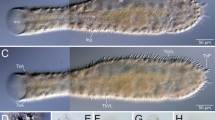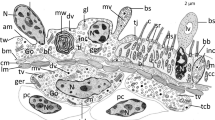Summary
A special vacuolized epidermis is found — unique amongst Gastropoda in the strikingly-coloured group of marine snails: Nudibranchia. The developmental changes and the fine structure of the epidermal cells from hatching until sexual maturity (development without free swimming veliger) has been descibed in the Eolid Trinchesia granosa The present paper deals only with the main cells, i.e. the vacuolar cells of the epidermis, while the less numerous mucoid and pigmentary cells are omitted.
While in the hatching stage the single-layered cells are separated by big intercellular clefts, they are closely interdigitated in the adult. With respect to differences in cell shape, position and structure of the nuclei, the fine structure of the cytoplasm, and the number of vacuoles, two main types of cells can be distinguished. They are characterized as A- and B-cells. A-cells and B-cells, as well as transitional forms can be observed in hatching animals, while in adult animals only A-cells are observed.
The epidermal cells of all developmental stages are characterized by “vacuole-bodies”, special structured ellipsoid bodies, each lying within a vacuole. The cell in the hatching stage contains only few vacuole-bodies, whereas they form an extremely dense layer in the apical part of the adult epidermis. Each vacuole-body consists of an ellipsoid viscous mantle and a dumb-bell shaped cylindrical axis containing a more or less osmiophilic nucleus. The electron microscopic findings indicate — in correlation with observations of the living epidermis — that the vacuole-bodies have absorbtive, filtrative and mechanic functions.
Similar content being viewed by others
Literatur
Bürgin-Wyss, U.: Die Rückenanhänge von Trinchesia coerulea. Rev. suisse Zool. 68, 461–582 (1961).
Edmunds, M.: Protective mechanisms in the Eolidacea (Mollusca Nudibranchia). Journ. Linn. Soc. London 46, 27–71 (1966).
Graham, A.: The structure and function of the alimentary canal of Aeolid Molluscs, with a discussion on the nematocysts. Trans. roy Soc. Edinb. 59, 267–307 (1934).
Haefelfinger, H. R.: Hervia costai (n. nom.), ein wieder entdeckter Opisthobranchier des Mittelmeeres. Rev. Suisse Zool. 68, 207–217 (1961).
—: Quelques faits concernant la nutrition chez Favorinus branchialis (Rathke 1806) et Stiliger vesiculosus (Deshayes 1864), deux Mollusques Opisthobranches. Rev. Suisse Zool. 69, 311–316 (1962).
Henneguy, L. F.: Contribution à l'Histologie des Nudibranches. Arch. Anat. micr. Morph. exp. 21, 400–466 (1925).
Humphreys, A.: Electron microscope studies on eggs of Mytilus edulis. J. Ultrastruct. Res. 7, 467–487 (1962).
Krembzow, E.: Über den Bau und die Entwicklung der Rückenanhänge von Äolidiern. Arch. mikr. Anat. 59, 181–210 (1902).
Kurosumi, K.: Electron microscope analysis of the secretion mechanism. Int. Rev. Cytol. 11, 1–124 (1961).
Merton, H.: Untersuchung über die Hautsinnesorgane der Mollusken. Abh. Senckenberg naturforsch. Ges. 36, 449–473 (1914).
Necco, A., and R. Martin: Behaviour and estimation of the mitotic activity of the white body cells in Octopus vulgaris cultured in vitro. Exp. Cell Res. 30, 588–623 (1963).
Perrier, R., et H. Fischer: Cavité palléale et ses dépendances chez les bulléens. Ann. Sci. nat. Zool. 14, 1–181 (1911).
Petry, G., u. W. Kühnel: Beitrag zur Kenntnis des Baues von Basalmembranen. Z. Zellforsch. 64, 533–540 (1964).
Raven, Chr. P.: Morphogenesis: The analysis of molluscan development. London and New York: Pergamon-Press 1958.
Rebhuhn, L.: Electron microscope studies on the vitelline membrane of the surf clam, spisula solidissima. J. Ultrastruct. Res. 6, 107–122 (1962).
Ruska, H., D. Moore, and J. Weinstock: The base of the proximal convoluted tubule cells of the rat kidney. J. biophys. biochem. Cytol. 3, 249–254 (1957).
Schmekel, L.: Zwei neue Arten von der Familie Cuthonidae aus dem Golf von Neapel: Trinchesia granosa n. sp. und Trinchesia ocellata n. sp. Publ. Staz. Zool. Napoli 35, 13–28 (1966).
Schwalbach, G., u. K. Lickfeld: Die Epidermis-Morphologie der Sinneskalotte von Helix pomatia L. Z. Zellforsch. 58, 277–288 (1962).
Trinchese, S.: Aeolididae e famiglie affini. Mem. Cl. Sci. fis. mat. nat. 11, 86 (1888).
Vignon, P.: Différenciations cytoplasmiques. Cils vibratiles et cuticules. Arch. Zool. exp. gén. 9, 3–18 (1901).
Author information
Authors and Affiliations
Additional information
Mit Unterstützung durch den Schweizerischen Nationalfonds zur Förderung der Wissenschaften und die Deutsche Forschungsgemeinschaft.
Rights and permissions
About this article
Cite this article
Schmekel, L., Wechsler, W. Elektronenmikroskopische Untersuchungen über Struktur und Entwicklung der Epidermis von Trinchesia granosa (Gastr. Opisthobranchia). Zeitschrift für Zellforschung 77, 95–114 (1967). https://doi.org/10.1007/BF00336701
Received:
Issue Date:
DOI: https://doi.org/10.1007/BF00336701




